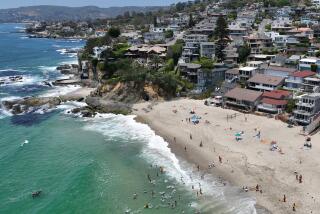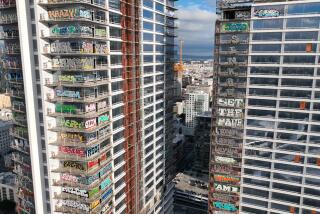Waterfront Plan Hotly Debated at Hearing
Opponents and proponents of a $100-million entertainment complex planned for the Long Beach waterfront clashed Thursday during a daylong hearing before state officials charged with overseeing land use along the California shoreline.
At issue is whether the controversial Queensway Bay project--an 18-acre mix of restaurants, theaters and retail stores--conforms with state law that regulates what can be built on coastal land owned by the state.
Backers of the project told representatives of the State Lands Commission that the businesses proposed for Queensway Bay meet the requirements of the State Tidelands Trust by creating a waterfront experience that can be enjoyed by millions of people.
Critics of the development, however, called on the commission to formally investigate Queensway Bay, as well as other shoreline projects in Long Beach. They say these projects violate state law because they are not harbor- or ocean-related uses. They say millions of dollars in state funds have been misspent on failed shoreline development.
“A Borders Bookstore, a Cost Plus and an Edwards theater are not permitted uses. We urge you to look further,” said Don May, president of California Earth Corps., a statewide environmental group.
The State Lands Commission convened the public hearing to help determine whether the project is permissible under the Tidelands Trust, a body of law that allows for development related to commerce, navigation, recreation and fisheries. Staff members will issue a report in the months ahead and recommend further action to the commission if necessary.
Under agreements with the state, many coastal cities, including Long Beach, are entrusted with managing shoreline areas. Government revenue generated from development of those lands, such as port fees, can be used only for projects permitted by the Tidelands Trust.
Over the years, court rulings have determined that certain recreation centers, restaurants, shops, and convention and banquet facilities are appropriate under the law.
The Queensway Bay complex has been described as a cornerstone of the city’s effort to regain the reputation it had as a tourist mecca during the first half of the last century. Supporters say the project will once again make the Long Beach waterfront attractive to millions of people.
“This will be a major visitor destination, much like the Third Street Promenade in Santa Monica, CityWalk at Universal Studios or the Irvine Spectrum,” said Bob Paternoster, who is the project manager for the city. “This will not be shopping mall, but a world-class urban waterfront.”
Long Beach Deputy City Atty. Jim McCabe told commissioners that the commercial uses planned for the project will make the city’s shoreline a viable and accessible public resource--something, he contends, is allowed by the law.
But Marc Wilder, a former Long Beach city councilman, said that, under the Long Beach Tidelands Trust Agreement, the mix of restaurants, theaters, nightclubs and shops proposed for Queensway Bay is prohibited.
Wilder and other critics said the city has a history of failed redevelopment projects and has repeatedly misappropriated Tidelands Trust money to further its own development and business objectives.
They cited $58 million spent on the Queen Mary in the early 1970s, the failed Long Beach Plaza shopping center and the Hyatt Regency Hotel, which faced bankruptcy and foreclosure in the mid-1990s before the city helped provide massive debt relief.
“Long Beach has an aquarium, a big empty dome, a street race and a beached liner,” said Doug Korthof, who lives in neighboring Seal Beach. “Now they want shops and theaters on the tidelands. They could be built in Anza Borrego or Des Moines. Maybe they could show surf movies to get compliance.”
More to Read
Sign up for Essential California
The most important California stories and recommendations in your inbox every morning.
You may occasionally receive promotional content from the Los Angeles Times.










